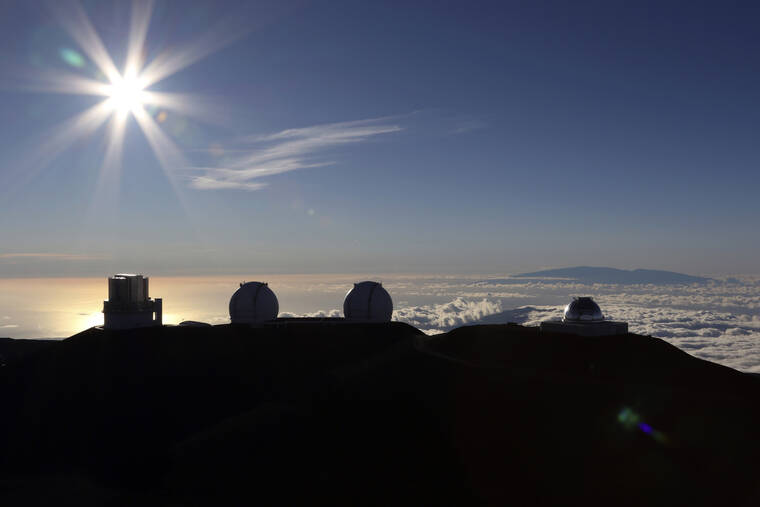Hawaiian culture, land should top astronomy at peak, report says

ASSOCIATED PRESS
The sun set behind telescopes, in July 2019, at the summit of the Big Island’s Mauna Kea in Hawaii. A working group tasked by the state Legislature to come up with recommendations for a new management plan for Hawaii’s tallest peak and its affiliated telescopes released the first draft of its proposal today.
A working group tasked by the state Legislature to come up with recommendations for a new management plan for Hawaii’s tallest peak and its affiliated telescopes released the first draft of its proposal today.
Mauna Kea is the proposed site for what would be the world’s largest optical telescope — the Thirty Meter Telescope. The giant telescope project has sparked a cultural movement among Native Hawaiians who believe the mountain is sacred. Construction of the massive instrument has been blocked by opponents.
The group, which was asked in a House resolution earlier this year to develop the report, suggested a new governing entity for the mountain, which is managed by the University of Hawaii.
The group recommended that the university not have a seat on the board of the new governing body. The university’s lease expires in 2033.
“The University of Hawaii was represented at the table during the working group discussions,” said the group’s chairperson, Rep. Mark Nakashima, a Democrat whose Hilo district includes Mauna Kea. “One of the premises of the resolution was that the university failed in some of its duties and responsibilities to the Native Hawaiian population, and so it was not included in the final management structure.”
The group could not come to a consensus on whether someone from the astronomy field should participate and recommended any such involvement be in an advisory capacity.
Don't miss out on what's happening!
Stay in touch with breaking news, as it happens, conveniently in your email inbox. It's FREE!
The group did not discuss or make any recommendations about the Thirty Meter Telescope project.
“The working group early on discussed the fact that … some of those decisions were not in our control,” Nakashima said.
“Other entities have come down and decided that, not the least of which is the Hawaii Supreme Court,” he said. “And so we did not touch upon that discussion.”
The proposed management structure should include many Native Hawaiians, especially those from the Big Island where Mauna Kea stands, the reports said.
Native Hawaiian Pualani Kanahele, one of the group’s cultural advisers, is relieved to have Indigenous voices at the table.
“I’m just happy at the fact that at this time we are allowed to have input into what goes on on the mountain,” she said. “We included a lot of cultural aspects in the report.”
The group recommended the eventual decommissioning of the telescopes that sit atop the mountain and to have those areas restored to their natural state. The group emphasized cultural and environmental restoration of the mountain.
It also said the new management team should develop a framework that limits the development of new observatories on the summit.
The mountain is already home to more than a dozen of the world’s most advanced telescopes.
Opponents of the telescopes say Mauna Kea’s observatories desecrate the peak and harm the environment.
Scientists and other supporters of the telescopes say the summit offers some of the best conditions for astronomical observations in the world. Some of the research from Mauna Kea has contributed to science’s understanding of black holes and gravity, among other major breakthroughs.
The report will be open to public comment until early January. The group will conduct a final review and submit its recommendations to state lawmakers to be considered.



